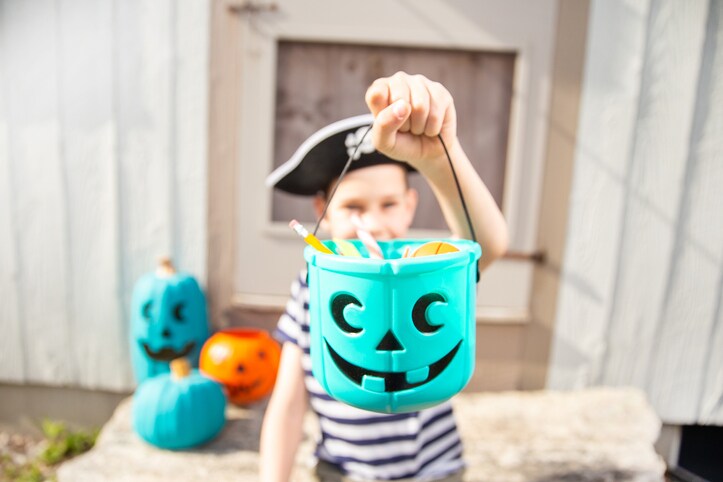Across the U.S., Halloween is a right of passage for children. Kids and families can get creative, wear costumes, gather with friends and, most importantly, go trick or treating. However, for parents of a child or children with food allergies, Halloween can feel like entering a minefield. One in 13 kids has a food allergy, according to Food Allergy Research & Education (FARE), and to help those kids enjoy the holiday, FARE has created a special initiative: the Teal Pumpkin Project.
You’ve likely seen teal pumpkins lining the neighborhood in recent years, and maybe you’ve even wondered, “What does a teal pumpkin mean?” The answer is that it’s a symbol to families impacted by food allergies that the house in question has safer, non-food treats for their kids to enjoy.
Here’s everything you need to know about the Teal Pumpkin Project and how to participate.
What is the Teal Pumpkin Project?
The Teal Pumpkin Project started in 2012 as a local awareness initiative created by the Food Allergy Community of East Tennessee (FACET). In 2014, FARE took the movement wider, spreading the message across the U.S. and globe. Families participating in the Teal Pumpkin Project select non-food items like small toys, stickers, crayons, trinkets to hand out to trick-or-treaters. Then, they place a teal colored pumpkin on their doorstep or sign on their door to signal that they have treats for children who have food allergies or other food-based health issues like celiac disease or diabetes.
How the Teal Pumpkin Project promotes safety and inclusion
The Teal Pumpkin Project ensures more kids will have an opportunity to enjoy Halloween safely. Food allergies can lead to severe sickness, breathing problems, vomiting, breaking out in hives or full blown anaphylaxis — even death. As a food allergy mom myself, I know what this can look like all too well. When my oldest was 2 years old, he went into anaphylaxis and almost died. This means I don’t know if the Halloween candy my children will get when trick or treating is safe for them. But seeing a teal pumpkin helps parents like me know which houses might provide safer options for our kids.
“If folks find joy in passing out candy treats for kids on Halloween, I’m pretty sure they would find just as much joy in providing non-food toy treats to kids as well.”
—Yvette, parent of a 9-year-old with food allergies
“The more people know about the Teal Pumpkin Project, the more non-food treats can be available for all kids to enjoy trick-or-treating,” adds Yvette, a Brooklyn-based parent of a 9-year-old who has food allergies. “If folks find joy in passing out candy treats for kids on Halloween, I’m pretty sure they would find just as much joy in providing non-food toy treats to kids as well.”
And if you have concerns about how to keep every kid happy, “non-food allergic children also enjoy receiving toys and trinkets for Halloween,” they add. In fact, Yvette is heartened that they’ve “met dozens of families who do not have food allergies but have taken it upon themselves to be inclusive around Halloween and other celebrations.”
How do you participate in the Teal Pumpkin Project?
Anyone can get involved with the Teal Pumpkin Project. Here’s how to participate:
1. Make or buy a teal pumpkin, sign or flag
Get a teal pumpkin symbol to place outside of your home. You can do this in one of several ways:
- Paint a real pumpkin teal and place it outside.
- Purchase a teal pumpkin online (for example, this glowing teal pumpkin from Target).
- Print a free teal pumpkin sign from FARE.
- Buy a teal pumpkin yard flag.
- Bag leaves in teal pumpkin leaf bags.
- Use a teal pumpkin treat bucket.
2. Register your address
Next, go to the FARE site and add your home and/or business to the organization’s Teal Pumpkin Project Map.
3. Stock up on non-food Halloween treats
Finally, make sure your non-food treats are safe. Yvette suggests getting non-food treats like pencil toppers, slime, stickers or yo-yos. Other options:
- Bookmarks.
- Magnets.
- Glow sticks.
- Temporary tattoos.
- Stickers.
- Bouncy balls.
- Key chains.
Keep in mind that some non-food items include allergens, like wheat, food dyes, sesame oil, etc. so check ingredients of all the items carefully.
“Be sure to keep non-food items separate from food to preempt introducing potential food allergens onto your non-food toys or trinkets.”
All parents should also be sure to double-check their children’s treats and candy at home, even if a trick-or-treat spot has a teal pumpkin outside. Most importantly, be sure to keep non-food items separate from food to preempt introducing potential food allergens onto your non-food toys or trinkets.
The bottom line
Every parent wants to ensure their kid gets to enjoy typical childhood celebrations, like Halloween, which is why it’s so heartening when food allergic kids are automatically included in events, parties and local celebrations. “Inclusion doesn’t mean not having candy at all,” points out Yvette, who simply encourages families to consider having safer treats on hand to pass out.
As a food allergy parent myself, I rely on careful planning for my children to have a fun Halloween. The Teal Pumpkin Project makes this process easier, and it’s so simple for other families to participate. As Yvette concludes, all it takes is “creativity and inclusivity” to ensure children who have food allergies have fantastic — and healthy — experience on Halloween.





